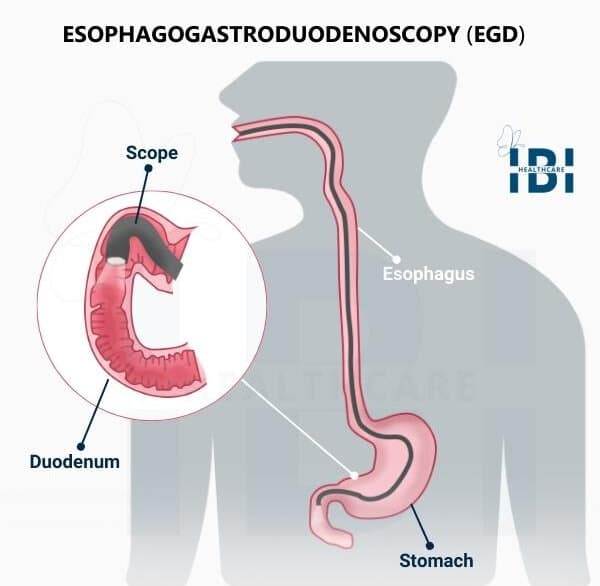EGD Procedure - Upper GI Endoscopy
Access expert EGD – Upper GI Endoscopy services at our advanced endoscopy center. Discover what happens during an EGD procedure, from sedation to endoscope insertion, for a better understanding of the process.
There are many diseases and conditions that an individual can experience that relate to their stomach, esophagus, or intestines. For example, a patient may suffer from chronic heartburn or have unexplained long-term nausea or vomiting. And doctors want to determine what is causing these symptoms. Additionally, they may order an esophagogastroduodenoscopy, upper GI endoscopy, or EGD. These are the medical abbreviations for tests to help them diagnose these issues.
EGD Procedure Overview
A doctor performs an upper GI endoscopy (EGD) using an endoscope. Then visualize and closely examine the lining of your upper GI tract.
Furthermore, an endoscope is a special flexible tube with a camera and a light mounted on its end.
The doctor can examine the patient’s entire upper gastrointestinal tract. Precisely the beginning at the mouth to the duodenum, i.e. the small bowel.
Upper GI Endoscopy - Important Consideration
A doctor would use EGD to help locate the cause of unexplained symptoms. That may be definitive of disease or infection such as:
- Chronic heartburn.
- Difficulty in swallowing.
- Nausea and/or vomiting.
- Gastritis occurs when the lining of the stomach becomes inflamed.
- Ulcers can develop in the esophagus, stomach, or duodenum. They occasionally become cancerous.
- Bleeding.
- Unexplained Weight loss.
- Upper abdominal pain or indigestion.
- Tumors of the stomach or esophagus.
- Esophagitis and chronic inflammation of the esophagus due to a backup of stomach acid and digestive fluids
Associated Risk
Likewise, with any surgery, therisks associated with single anastomosis sleeve ileal bypass may include:
- Celiac disease.
- GERD (Gastroesophageal reflux disease).
- Chemical damage after accidental ingestion.
- Cancer (EGD with a biopsy is used to confirm).
- Blockages.
- Narrowing of the esophagus.
- Precancerous conditions such as Barrett’s esophagus.
Who is a Candidate for EGD?
Do you have difficulty swallowing, pain in the upper abdomen, or unexplained heartburn? In particular, individuals have chronic digestive issues and unexplained weight loss. As well as continuing symptoms of reflux are good candidates for upper GI endoscopy.
What do I need to do to Prepare for the Procedure?
EGD prep is important and necessary to ensure patient safety during the procedure. Each patient’s doctor will provide them with specific instructions. Regarding the use of medications they normally take (blood thinners or high blood pressure medications) before their procedure. In general, doctors do not allow any eating or drinking for at least eight hours before the procedure.
How do Doctors Perform Upper GI Endoscopy?
Doctors normally perform EGD as an outpatient procedure. Therefore, it does not require a hospital stay. Knowing what to expect from the EGD procedure should help alleviate some anxiety and make the process go more smoothly.
While the patient is under mild sedation. A gastroenterologist or surgeon carefully lowers the endoscope down the patient’s throat and into the upper GI tract.
Whereas, the tiny endoscopic camera sends a video image to a monitor. That is located next to the doctor allowing a direct examination of the upper GI tract lining. The doctor pumps air through the endoscope to widen these areas. Moreover, making it easier to access and inspect for abnormalities.
However, if necessary, the doctor will take a small tissue sample from the lining. To send to a lab for review but the patient will not feel anything (EGD with biopsy). During the upper GI procedure, the doctor can also remove polyps and tumors.

How long does the Procedure Take?
The doctor does not make any incisions. And carries out the entire process as an outpatient procedure in less than 30 minutes. Additionally, it offers a quick recovery.
What can I Expect after an EGD Procedure?
You may be groggy due to the sedative after the procedure. Eventually will need a friend or family member to drive you home. The doctor will not allow you to drive an automobile after the procedure. Even though you may not feel tired, your judgment and reflexes will most likely impaired. Thus, make sure you have someone with you.
Overall, EGD has minimal recovery or discomfort. You may experience a sore throat for 1–2 days, have difficulty swallowing, or feel bloated. If used, the IV sedation may cause soreness in the location where it administered. These mild side effects should dissipate within 48 hours.
When will I get the Results?
The physician may explain the results after the exam or may suggest an appointment for a later date. Specially, when the patient can fully understand and remember the results. Often, a side effect of sedation causes patients to not remember anything about the procedure or directly afterward. If a biopsy performed or a polyp removed. The results will not be available for three to seven days.
What are the Risks of an Upper GI Endoscopy?
Generally, EGD is a very safe procedure with no associated major risks or complications. Sometimes, patients experience a temporary, mild sore throat after the exam but this normally resolves within a few days.
Serious risks are rare with upper GI endoscopy and may include excessive bleeding, especially with the removal of a polyp. In extremely rare instances, a perforation, or tear, in the esophagus or intestinal wall can occur requiring hospitalization or surgery. In very rare circumstances, a diagnostic error or oversight may occur.
How much does EGD cost?
The average cost of an upper GI endoscopy is between $787 to $3,382 in the United States. Although will vary depending on many factors. Such as patient-specific criteria, any additional testing that may be necessary during the procedure, geographic location, and insurance coverage. Medical insurance may cover some or all of the costs of the upper GI endoscopy (CPT code for EGD 43235).
However, patients must check the coverage that is available on their plan before scheduling the procedure. EGD with biopsy (CPT code 43238) and EGD with dilation (CPT code differs depending on the dilation technique). Also, it may require pre-authorization. Many insurance companies require a detailed history of symptoms and documentation of treatments before they will approve the procedure.
What is an EGD with Biopsy?
During the upper GI procedure, the doctor sometimes gathers a small sample of tissue. To further diagnose or confirm the presence of conditions such as cancer, celiac disease, and gastritis.
What is an EGD with Dilation?
Sometimes, scarring from chronic reflux. In other words, acid repeatedly backs up into the lower portion of the esophagus. It can cause the tube to become constricted making it hard for the patient to swallow. When they eat, their food feels “stuck” around their upper chest causing discomfort or pain.
Though less common, thin layers of excess tissue caused by cancer. As a result, radiation treatment can cause narrowing. Doctors perform esophageal dilation or EGD with dilation. To stretch or dilate a narrowed portion of a patient’s esophagus (the tube for swallowing). There are different techniques that doctors use to perform esophageal dilation.
What is the difference between EGD and a Colonoscopy?
Both an upper GI and a Colonoscopy are procedures that utilize endoscopic technology to examine sections of the digestive system. During an EGD, doctors examine the upper portion of the digestive tract through the mouth. While a colonoscopy performed through the rectum to examine the lower part of the GI tract. Call us or schedule a consultation to inquire about procedure costs and flexible financing options.






